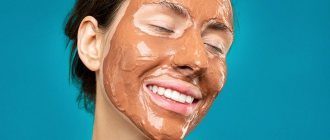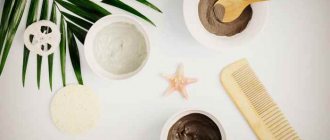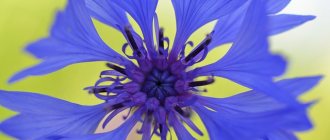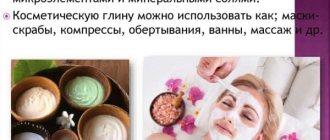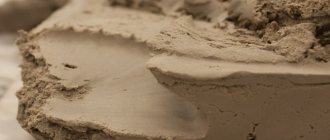Clay is a mixture of zinc oxide and aluminum oxide, with the addition of coloring ions and organic substances. It contains a lot of macro- and microelements, phosphates, nitrogen and iron. .
Clay is able to absorb and retain moisture with substances dissolved in it, which is often used to cleanse the skin of toxins. There are many different types of clay depending on its composition and place of origin. Its use also depends on this.
Clay is an excellent remedy for solving many cosmetic problems. Pharmacies and specialized stores sell several types of clay, differing in color, composition, and therefore their properties. .
Black clay (Dead Sea clay)
This clay contains iron, magnesium, calcium, strontium and radium. Masks with black clay cleanse the skin of impurities and tighten pores . This clay is recommended for oily skin, because... it improves blood circulation, lymph circulation and other metabolic processes. Masks based on black clay increase skin regeneration, remove inflammation, moisturize and tone.
Read more…
Black clay gives a quick effect of reducing volumes and removes swelling.
The best natural remedy to combat cellulite and fat deposits. Most often used to wrap problem areas. But it is also popular as a face mask. Especially with deep wrinkles on the forehead and nasolabial folds. ! Thanks to its detoxifying properties, black clay is especially useful at the end of the day, when you return tired and inhaled from city dust and exhaust fumes.
Deep cleansing for oily skin. 1 tbsp. a heaped spoon of black clay, 1 teaspoon of calendula tincture, 1 teaspoon of lemon juice. Dilute the clay with hot boiled water until it becomes thick sour cream, add the tincture and juice, mix. Let it brew and apply to the face, avoiding the area around the eyes. Leave for 10 minutes and rinse with warm water. The mask can be done once a week.
Characteristics and properties
The clay contains silicon and aluminum components. The most common impurities are iron hydroxide, alkali earth metal oxides, quartz and iron sulfide. Rocks with a high alumina content are used to produce refractory materials; the alumina content in such rocks ranges from 25 to 30%.
When all types of clays get wet, water fills the gaps between the particles, as a result of which they easily move relative to each other. This property determines the plasticity of clay materials.
Clay material is widespread in nature. Clays are divided into subgroups depending on the mineral composition and particle diameter, the presence of certain impurities. There are these types of clay:
- red,
- white,
- sandy,
- clay for porcelain,
- kaolin
Red clay
The granulometry of certain types of materials depends on the mineral components and chemical composition. Almost all varieties of this unique fossil are characterized by plasticity, adsorption, and swelling. When wet, shrinkage and swelling are characteristic; these properties are decisive when using the material in industry.
According to industrial technical requirements, rock is divided into varieties:
- low-melting,
- refractory,
- adsorption,
- kaolin
Soaked clay becomes plastic and can take almost any shape.
Plastic masses are called “greasy” because they feel like a greasy material to the touch. Varieties of clays with a low degree of plasticity are called “lean” or lean. Products made from such materials quickly crumble; “lean” clay is not suitable for brick production.
- Dried clay holds the shape it was given well, while it slightly decreases in volume, compacts, hardens and becomes as strong as stone. Due to these properties, clay has long been considered the most widely used material for making dishes and other household items.
- Among other things, this breed has the ability to be sticky.
- Having absorbed a certain amount of moisture, the material no longer allows water to pass through; this property determines the water resistance of the material.
- Another property of clay is its covering ability. Due to this property, clay has long been used to cover the walls of buildings and furnaces.
- The sorption capacity of the material makes it possible to use clay as a purifier of fats and petroleum products.
All of the above properties ensure a long service life for objects made from clay.
Yellow clay
Yellow clay contains a large amount of iron and potassium , this significantly improves oxygen supply to the skin, removes toxins and accelerates cell regeneration. Such masks are recommended for mature and aging skin, as well as for correcting cosmetic blemishes and solving skin problems.
Beautiful skin for those over 50+
Yellow clay masks have a pronounced tonic effect on the skin, improve color and add radiance. Yellow clay has a detrimental effect on pathogenic bacteria and fungi, cleanses the skin, heals, and removes toxins.
Ideally tones aging skin. Yellow clay is rich in iron and potassium. Improves complexion for dull, tired skin. It is able to saturate the skin with oxygen and remove harmful toxins during various inflammatory processes, including acne. Effectively reduces cellulite. Fights acne, exfoliates dead epithelial cells. ! Yellow clay masks are recommended as an emergency aid to improve complexion.
Rejuvenating mask . 14 g yellow clay, 18 g kelp, 10 g bodyagi, 2 ml grape seed oil. Grind kelp and bodyaga into powder, add 50 ml of hot boiled water, leave for 1 hour. Add clay powder and oil, mix until smooth. Apply to face and neck for 15 minutes. Rinse off with warm water.
Types of clays and their applications
The remarkable properties of natural mineral clays have been known since ancient times. Even then, clay was actively used not only in medicine, but also in cosmetology. Ancient healers made various poultices and rubs from it. Clay was taken internally when its absorbent effect was needed. It helped get rid of bacteria well and allowed toxins to be removed from the body. Clay therapy helped with various poisonings, epidemics and muscle pain. Now clay is no less popular. It is often used in dermatology. Medicinal ointments and pastes are made from it. Clay is also widely used in cosmetology. It is usually included in face masks.
The main property of cosmetic clay is cleansing and drying the skin. Clay is able to absorb excess sebum and sweat gland secretions. In addition, it perfectly cleanses the facial skin, eliminates peeling, irritation and redness. Clay masks in facial care can be used for both oily and dry skin. In addition, clay can enhance the bactericidal effect of certain substances. It is often added to anti-inflammatory ointments and masks. There are different types of cosmetic clays, which we will look at in this article.
Clays differ in color, which depends on their mineral composition. The composition of clays depends on their place of origin. Clay can be white, blue, green, red, yellow and black (gray). Each type of clay has its own specific qualities and is used in medicine and cosmetology for different purposes. You can buy natural cosmetic clay in pharmacies or cosmetics stores.
White Cosmetic Clay White clay (Kaolin) appears as a uniform white powder with a yellow or grayish tint or can be a dense piece. It feels greasy to the touch. It dries, cleanses and tightens the skin well. White clay is able to absorb excess oil, it significantly tightens pores. You need to know that this type of cosmetic clay also has a slight whitening effect. In addition, with its help, a woman can even out the oval of her face. White clay is also an excellent antiseptic. It is used as part of bactericidal and anti-inflammatory facial care products. Regular use of white clay will make your skin velvety and more elastic. Your complexion will improve and become fresher. White clay is the most common. It is on this basis that most face masks are made. It is hypoallergenic and suitable for all skin types, even the most sensitive, and for oily skin it normalizes the fat balance. Kaolin is a gentle abrasive, which allows it to be used as a soft scrub. This property of white clay is very valuable for skin with inflammatory acne, for which rough abrasives are unacceptable, as they can aggravate the course of this skin lesion. It is also used in the form of powders, ointments, pastes, as well as for diaper rash and burns. White clay is an indispensable component in cleansing masks. In addition, homemade tooth powder or paste with the addition of clay not only whitens the teeth even of heavy smokers and coffee drinkers, but also removes tartar, strengthens enamel, and reduces the threat of caries.
The darker the color of the clay, the better it will remove fat and deal more effectively with acne.
Blue cosmetic clay
This clay has anti-inflammatory properties and contains all the mineral salts and trace elements we need. It can prevent the appearance of acne and effectively accelerate the healing of skin wounds. This clay is great for cleansing facial skin and improving its color. Blue clay is also used to smooth out facial wrinkles. It rejuvenates the skin, making it firmer and more elastic. Blue clay can also lighten freckles and age spots. When used regularly, this type of clay can be a great help for problem skin. It disinfects and smoothes the skin, eliminates acne. Activates blood circulation and accelerates the metabolic process in skin cells. In addition, traditional medicine uses blue clay as a very effective remedy against baldness. Moreover, blue clay softens and tones the skin, and also has anti-cellulite, antibacterial and anti-stress effects. Foot masks based on blue Cambrian clay helped to improve the microcirculation of the skin of the lower extremities, which was expressed by increasing the firmness and elasticity of the skin, reducing swelling and the severity of the “feeling of heaviness in the legs.” Due to the high adsorption capacity of Cambrian clay, using a foot mask in the foot area for 20 minutes 1-2 times a week helps reduce the degree of sweating of the feet, eliminates unpleasant odor and can be used as a preventive measure for fungal and bacterial infections of the skin of the feet.
Green cosmetic clay
Green clay gets its color from iron oxide. Taken directly from the quarry, green clay appears as a dark green, wet mass. This clay has found wide application in cosmetology. It can be the basis for cosmetics, and also comes in the form of masks, wraps and compresses. Due to the content of a large number of microelements, it helps restore the skin's hydrobalance and has remarkable absorbent properties. Green clay softens and cleanses facial skin. It relieves irritation and has a drying effect. Green clay masks perfectly cleanse facial pores and eliminate oily shine. In home facial treatments, you can mix green clay with another type of clay.
Green clay has excellent absorbent properties. This is an ideal product for deep skin cleansing. Best suited for oily skin of the face and scalp, used to combat seborrhea. Helps narrow pores and improves the function of the sebaceous glands. Has excellent tonic properties. Causes blood flow to the surface of the skin and provides it with the necessary nutrition. Stimulates skin cell regeneration. Tightens the skin and restores the facial line. Effectively softens, smoothes wrinkles and relieves puffiness. Restores normal metabolism and has antibacterial properties, as it contains a large amount of silver. Baths with green clay cleanse and soften the skin, pleasantly relieve fatigue, stress and irritation due to its natural ability to remove all the negative energy accumulated during the day.
Red cosmetic clay
Red clay is this color due to a combination of iron oxide and copper. It is best suited for women with sensitive skin prone to allergic reactions. Masks made from this clay relieve irritation and redness on the face. They will also help get rid of flaking and itching of the skin. Red clay can also be used for dry, dehydrated skin. It will help aging and dull skin. This type of clay improves blood circulation and increases the saturation of facial skin with oxygen. It is also used for iron deficiency in the body - taken orally.
When rubbed into the scalp, red clay strengthens weak and brittle hair, nourishes hair follicles and treats oily seborrhea. The components of red clay effectively nourish and restore tired skin, help smooth out premature wrinkles, and also have the effect of “educating” involuntary facial expressions, especially in the forehead area.
Pink cosmetic clay
Pink clay does not exist in nature; it is the result of mixing white and red clay. This clay is perfect for caring for any skin type. Smoothes out small wrinkles, softens the skin, tightens the facial contour. Pink clay has a rejuvenating effect. Nourishes and cleanses the skin, makes it softer and gives elasticity. In addition, it is widely used in masks and applications for weakened hair and nails. Has a refreshing and restorative effect. Pink clay baths moisturize the skin, relieve fatigue, have a tonic effect and improve metabolic processes in tissues, creating a feeling of freshness and comfort.
Yellow cosmetic clay
Yellow clay contains a lot of potassium and iron, as well as a number of other rare trace elements. It saturates the skin with oxygen. Has a tonic effect. Quickly, effectively and permanently improves complexion. Nourishes hair and scalp, helps get rid of dandruff. Yellow clay is able to absorb waste products of the body and kill pathogenic bacteria. It saturates the skin with oxygen and removes harmful toxins during various inflammatory processes, including acne. Yellow clay is perfect for aging and tired skin. It smooths out wrinkles, softens and cleanses the skin well, gives it elasticity and freshness. Yellow clay also exfoliates dead skin cells, softening rough skin on the hands, elbows and feet; promotes healing of small cracks. Due to its high adsorption capacity, yellow clay effectively relieves sweating of the feet and eliminates their unpleasant odor. Yellow clay baths relieve fatigue after physical activity, improve metabolic processes in tissues, improve the condition of the skin, making it smooth and velvety.
Black (gray) cosmetic clay
Black clay contains strontium, quartz, iron, magnesium and calcium. It cleanses the skin very well. This type of clay can perfectly absorb all harmful toxins and impurities from the skin. Helps tighten facial pores. Suitable for normal, oily and combination skin.
The most active among all types of clays, it is mined at sea depths. This is one of the most powerful remedies in the eternal women's fight against cellulite and fat deposits. Black clay is used to nourish dehydrated, dry skin. It also relaxes tired muscles, relieves rheumatic pain and effectively fights bruises.
Green clay
It contains a large amount of iron oxide, copper, silver, zinc, calcium, phosphorus, cobalt and other elements. Green clay is recommended for those with combination to oily skin.
This clay perfectly normalizes the secretion of the sebaceous glands, helps get rid of excess oil and dry skin. Green clay masks help remove comedones and blackheads.
The rich composition of clay helps restore the skin's water balance, eliminates inflammation and irritation, improves capillary circulation, cleanses pores and eliminates oily shine.
It will heal the scalp and hair and help fight seborrhea. This clay is best suited for oily skin of the face and scalp, as it helps narrow pores, regulates the function of the sebaceous glands and has a tonic effect. Has antibacterial properties. ! An effective remedy for relieving puffiness.
Acne mask . 1 tbsp. a heaped spoon of green clay, 0.5 spoons of lemon juice, 0.5 spoons of grape seed oil, 4 drops of tea tree essential oil. Dilute the clay with hot boiled water, add juice and oils, mix thoroughly. Apply to clean face for 10 minutes, avoiding the eye area. Rinse off with warm water. It is recommended to make this mask no more than twice a week.
How to figure out which one is better
When choosing the required type, you should focus on your individual characteristics.
Oily skin type with a dense structure and thickened stratum corneum is characterized by enlarged pores, oily sheen, inflammation and comedones. For this type, using white, blue, green, black and yellow clay will be effective.
The dry type is characterized by peeling, redness, tightness, and sensitivity to irritation. This is caused by a lack of moisture and poor functioning of the sebaceous glands. For this type of skin, as well as those prone to allergic manifestations in the form of spots, gray and red are recommended.
For any other type, a universal pink one is suitable.
Take advantage of the given characteristics of this unique natural cosmetic product and make your individual choice.
Pink clay
This clay is universal and suitable for any skin type. It consists of equal parts of red clay and white kaolin clay. Pink clay tones the facial skin well, rejuvenates it, smooths out wrinkles and tightens the facial contour.
Masks with this clay improve metabolic processes in tissues, promote deep hydration of the skin, refresh and restore.
Moisturizing mask 1 tbsp. spoon of pink clay, 2 tbsp. spoons of warm cream, 1 teaspoon of honey, 1 teaspoon of aloe juice. Mix everything thoroughly. Apply to face for 12 minutes, rinse with cool water.
Pink clay is a natural remedy containing large amounts of pure silicon . Baths using pink clay have a very good effect on the skin, have a tonic effect on the entire body, remove toxins and heal the skin. ! Great for dry and normal skin.
Types of masks
We suggest considering several recipe options for homemade cosmetic products. Any clay will do (white, pink, red, black, green, etc.), it is important to choose a variation based on your skin type. For example, for a dry type there is a good choice of additives in the form of milk, sour cream, egg whites or herbal infusions with a drying effect, for a fatty type - yolk, low-fat kefir, yogurt, etc.
With clay and honey
honey and vitamins A and B are perfect (ampoules can be bought at any pharmacy). The honey should be liquid (a water bath will do), but not hot.
For dry, oily, combination skin
Manufacturers of cosmetic care products offer ready-made formulations. For example, TM IvRoshe face and hair mask with Moroccan clay reviews can be seen on their official website on the Internet. TM Avon, Pure Line, Oriflame, Grandma Agafya’s Recipes, etc.
. They also delight with a wide range. These compositions can be prepared independently by adding auxiliary components to the clay base:
- for dry – protein, oil (olive, sea buckthorn, etc.), fatty fermented milk products, milk are excellent;
- for fatty foods – yolk, tomato or onion juice, etc.
Clay mask for blackheads
A face mask with clay and gelatin (white, black, green, red, blue, pink, etc.) is perfect for solving this problem. First, dissolve the gelatin and leave it to swell, then add the clay composition (leave the gelatin in the water until completely dissolved).
Recipes for clay masks with: glycerin, bodyaga, tea tree oil, essential oils
We offer several proven home recipes for the face:
- blue, glycerin and bodyaga (in equal quantities) diluted to a light mushy state - rejuvenating ;
- pink with oil (better than tea tree) - this option is well suited for problem skin;
- white, essential oil (any) and honey - for tightening ;
- from blue, whey and oatmeal - cleansing ;
- from black, bodyagi and sour cream - tonic and nourishing ;
- green, oil (tea tree is better) and banana (mashed) - nutritious.
Some tips
- Most clays have a drying property, so in their pure form they are ideal for oily and combination skin.
- For normal and dry skin, it is better to use clay in masks, mixed with other ingredients (egg yolk, honey, dairy products, oils, etc.).
- To avoid the feeling of skin tightening, do not keep the clay mask on your face for more than 15 minutes. After using the clay mask, it is recommended to apply a nourishing cream to the skin.
- Based on clays, you can prepare any nourishing masks, such as fruit masks. In addition to its beneficial properties, clay also gives masks a pleasant consistency.
- Clay masks are not recommended to be used more than 3 times a week for oily skin and more than 1 time a week for dry skin.
- An excellent effect is achieved by adding essential oils to the clay (selected depending on the tasks and skin type).
- Clay can also be used as a light peeling when washing for daily skin care.
doclvs.ru
Attention!
The information on the site does not constitute a medical diagnosis or a guide to action and
is intended for informational purposes only.
Clay mask recipes
If you want to make your own acne mask, you may find the following recipes useful:
- Blue clay with essential oil
Dilute 1 tbsp. l. blue clay with a small amount of water, add 1-2 drops of peach oil, and then stir the composition well.
- Mask based on blue clay and badyagi
Prepare a mixture of 1 tbsp. l. blue clay and 1 tsp. cosmetic badya. Pour 15 ml of water into the resulting base, then mix well and apply to the skin in an even layer.
- Blue clay and cucumber acne remedy
Mix 1 tsp. water with the same amount of cucumber juice and 2-3 drops of lemon juice. Dilute the resulting liquid with 2 tbsp. l. blue clay and use the product as directed.
- Egg and honey mask based on white clay
Dilute 2 tbsp with water. l. white clay, add 1 tbsp. l. natural liquid honey and raw egg yolk. Mix the ingredients thoroughly and apply the product to the skin in a thick layer.
- White and blue clay mask with herbal decoction
Pour 1 tsp into a container. white clay and the same amount of blue. Dilute the clay mixture with a decoction of calendula, chamomile or nettle.
A properly prepared clay mask has a thick and viscous mushy consistency, without lumps or slurry. It is worth noting that a clay-based mask can cause irritation, itching, tightness and flaking of the skin. If you experience such phenomena after using the product, try adding olive oil to the clay composition before the next procedures, and after rinsing, complete your skin care by applying a nourishing cream.
Important!
Despite the fact that clay is a hypoallergenic product and has no contraindications for external use, when choosing a mask you must be very careful: some additional components included in the product can provoke an allergic reaction.
Before using the finished product for the first time, it is recommended to conduct a home allergy test. To do this, apply a small amount of the composition to the skin in the area of the wrist or the inside of the elbow, rinse off after 15 minutes, and periodically inspect the treated area for signs of allergy for 24-48 hours. If negative symptoms appear (severe redness, rash, swelling, severe itching and burning), you must stop using the mask.
